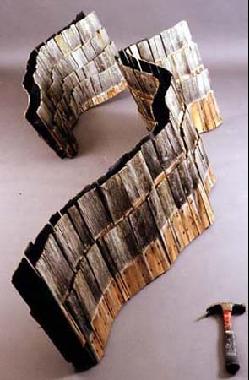Pictures





I work as a sculptor and printmaker who is expressing outrage at the destruction of the natural world. My sculpture installations and work on paper demonstrate the folly of our present way of life. It is not news to the thinking population that overcrowding and materialism as well as the consumption of petroleum and gas are are ruining the planet, but I hope that my contribution to the body of work that addresses these issues plays a part in awakening the collective conscience to this disaster. While work that I made earlier in the decade (in 2002 - 2005 ) celebrated the emotive power of land and seascapes, my more recent sculptures and prints have been focused on the obvious depradations caused by oil and gas consumption. My latest exhibition at the SOHO20 Chelsea Gallery in New York City protested the advance of the technology that produces petroleum products as well as the technology of hydrofractile drilling for gas.
The concept of each piece springs from the materials that I use to construct it. I have probably arrived at this method of working from printmaking, my first art form. Printmaking is a discipline in which the combination of texture and line builds up a low relief surface. The three dimensional aspect is essentail to the final image. In sculpture, texure in the form of woven twigs, cane and reeds was an important aspect of the medium. I combined it with anthropomorphically shaped pieces of trees . Then reconstituted building materials like shingles, vinyl roofing and architectural elements entered the store of materials I combined objects formed or deformed by nature - rusted metal and oddly shaped wood - with steel pipes, lumber and detritus to make pieces that satirize the present day infatuation with petroleum production. Recently I have added pieces of cut out steel which I coast with polyesters to produce convincing replicas of oil pools and drips. Some of these constructions appear out of balance . They defy gravity and intuition and are a conscious reflection on the state of civilization. Others comment on the ambiguity of 'framing' whether with old windows, projectors, or image traps like cameras and telescopes. The most recent work addresses the conversion of natural elements into ones that will destroy the world as we know it. While the process of 'refinement' is kept hidden in containers that are 'plain pine boxes', the implication of change is evident in the twisted dying trees that reach towards the sky justaposed with industrial related steel piples and equipment. Other works consist of pure found elements recontextualized in a gallery setting.
My recent prints are directly related to the content of my sculpture. In fact the plates from which I print move on to become larger three dimensional pieces. The etched metal ( aluminum or steel ) is printed in small editions. ( I keep the editions small because I detest the concept of mass production. Etching produces unique and lovely effects but there is no need to leave a hundred identical images to posterity. Once I have made a limited edition of prints, I cut out what I consider the important parts of the plates and mount them on the wall as low relief sculptures or weld them into standing steel forms.s in an exhibition, "Long Shots" at the SOHO20 Gallery in New York.
My earlier work done during the 80s and 90s was strongly influenced by the impermanant art of pre-literate cultures. I was captivated by the care and devotion that was obvious in artifacts that were used for only a single ritual and then discarded. These fragile structures were used to convey important histories, concepts, lineages and information. As long as the culture was intact, they held meaning for the people who used them. Steel, bronze, and even stone, while lasting, were not essential to conveying an idea or recording events. Once the culture disappeared, the more ephemeral objects also vanished. Ironically, when it comes to considering those artifacts that were actually made of more permanent materials, we find that the the meaning and use of them has often been lost. No one really knows why the sculptures of Easter Island were made, or who erected them. The prehistoric standing stones of the British Isles and France are still subject to much speculation.
At present I use more permanent materials not because I really want my work to last through the ages, but because the modern mind relates to them more easily than it does to the evanescent detritus of the past.
7/07/11
Lucy's Art can be found at The YOHO Artist Studios at 540 Nepperhan Avenue, Yonkers, NY, 10701-6630, one of the largest growing artist communities in Westchester, NY.




